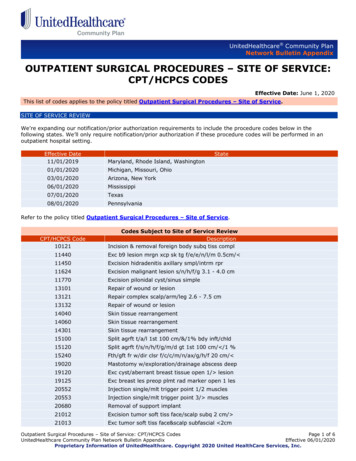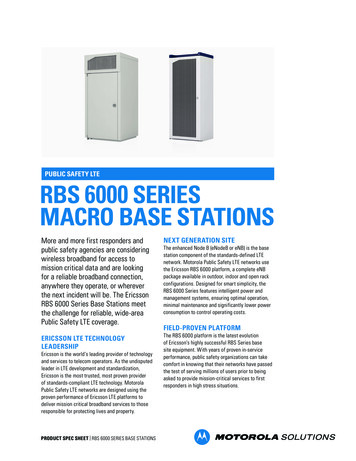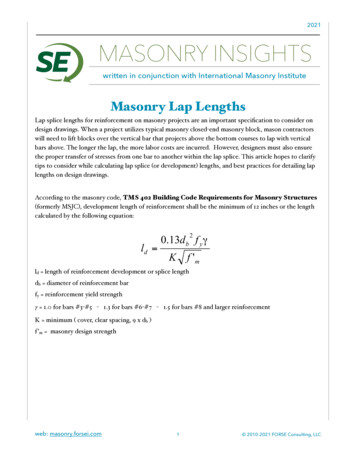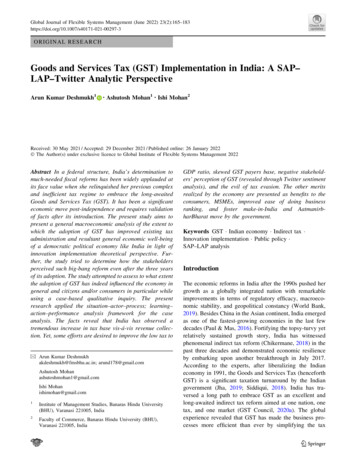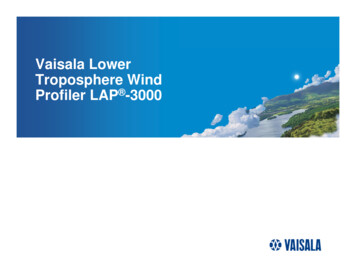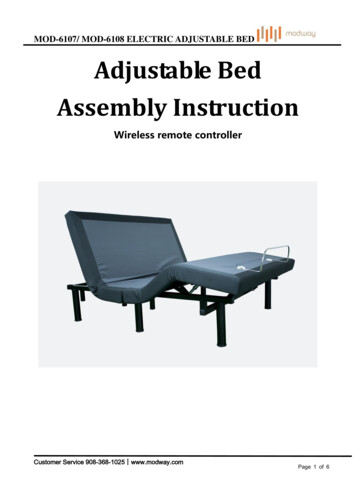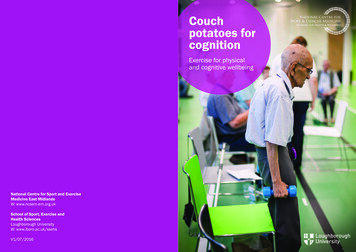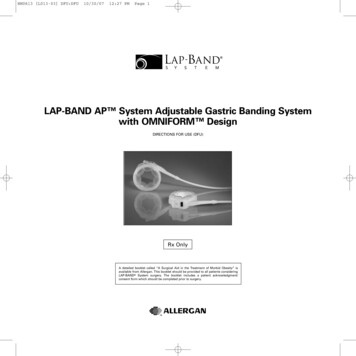
Transcription
HM0613 [L013-03] DFU:DFU10/30/0712:27 PMPage 1LAP-BAND AP System Adjustable Gastric Banding Systemwith OMNIFORM DesignDIRECTIONS FOR USE (DFU)Rx OnlyA detailed booklet called “A Surgical Aid in the Treatment of Morbid Obesity” isavailable from Allergan. This booklet should be provided to all patients consideringLAP-BAND System surgery. The booklet includes a patient acknowledgment/consent form which should be completed prior to surgery.
HM0613 [L013-03] DFU:DFU10/30/0712:27 PMPage 2
HM0613 [L013-03] DFU:DFU10/30/0712:27 PMPage 3Description .1Intended Use / Indications.1Contraindications .1Warnings .1Precautions.1Adverse Events .2Clinical Experience .3Individualization of Treatment.4Patient Counseling Information.4How Supplied .5Operator’s Manual.5LAP-BAND AP System Surgical Procedure.6Instructions for Use: Band Adjustment .7Authorized Training Program and Product Ordering Information .8
HM0613 [L013-03] DFU:DFU10/30/0712:27 PMPage 4
HM0613 [L013-03] DFU:DFU10/30/0712:27 PMPage 1LAP-BAND AP Adjustable Gastric Banding SystemDESCRIPTIONCat. No. B-2240LAP-BAND AP System Standard w/Access Port Ireduction alternatives, such as supervised diet, exercise andbehavior modification programs. Patients who elect to have thissurgery must make the commitment to accept significantchanges in their eating habits for the rest of their lives.Cat. No. B-2245LAP-BAND AP System Large w/Access Port ICONTRAINDICATIONSCat. No. B-2260LAP-BAND AP System Standard w/Access Port IICat. No. B-2265LAP-BAND AP System Large w/Access Port IIThe LAP-BAND AP Adjustable Gastric Banding System isdesigned to induce weight loss in severely obese patients bylimiting food consumption. The band’s slip-through buckledesign eases laparoscopic placement around the stomach,allowing the formation of a small gastric pouch and stoma. Nocutting or stapling of the stomach is required, and there is nobypassing of portions of the stomach or intestines.The LAP-BAND AP Adjustable Gastric Banding System withOMNIFORM Design is the latest advance in laparoscopicadjustable gastric banding for the treatment of morbid obesity.The initial pouch and stoma sizes are established through the useof the calibration tube. The inner surface of the band is inflatableand connected by kink-resistant tubing to the Access Port, whichis included in the LAP-BAND AP System. This permits postoperative, percutaneous, stoma-size adjustment. Dietary andbehavior modification counseling and frequent, long-term followup are required for all patients after weight-loss surgery.Surgeons planning laparoscopic placement must have extensiveadvanced laparoscopic experience, i.e., fundoplications as well asprevious experience in treating obese patients, and have the staffand commitment to comply with the long-term follow-uprequirements “of obesity procedures. They should comply withthe American Society of Bariatric Surgeons (ASBS) and theSociety of American Gastrointestinal Endoscopic Surgeons(SAGES) joint “Guidelines for Surgical Treatment of MorbidObesity” and the SAGES “Guidelines for Framework for PostResidency Surgical Education and Training”. Surgeonparticipation in a training program authorized by Allergan or byan authorized Allergan distributor is required prior to use of theLAP-BAND AP System. Please see the last page for directionson obtaining additional information.Brief Description of ProcedureDuring the surgical procedure, the inflatable band is flushed withsterile saline. The band is placed around the stomach andinflated with sterile saline to create the proper stoma diameterand pouch size using the calibration tube. The tubing isconnected to the Access Port placed on the rectus muscle or fixedin an accessible subcutaneous space. Arrows pointing in thedirection of the Access Port are printed on the tubing. Thesearrows assist the surgeon in identifying the correct tubingorientation. The tubing may be shortened to tailor the position ofthe port to the patient. The two components are joined with thestainless steel tubing connector. Ligatures may be placed on bothtubing ends over the connector. The Access Port may then besutured in place utilizing the suture holes in the port base.Postoperatively, the surgeon may adjust the stoma sizepercutaneously by injecting or aspirating saline with the AccessPort needle.Please refer to the Surgical Procedure section for moreinformation.INTENDED USE/INDICATIONSThe LAP-BAND AP System is indicated for use in weightreduction for severely obese patients with a Body Mass Index(BMI) of at least 40 or a BMI of at least 35 with one or moresevere comorbid conditions, or those who are 100 pounds ormore over their estimated ideal weight according to the 1983Metropolitan Life Insurance Tables (use the midpoint formedium frame). It is indicated for use only in severely obeseadult patients who have failed more conservative weightThe LAP-BAND AP System is contraindicated in:1. Patients with inflammatory diseases of thegastrointestinal tract, including severe intractableesophagitis, gastric ulceration, duodenal ulceration, orspecific inflammation such as Crohn’s disease.2. Patients with severe cardiopulmonary diseases or otherserious organic disease which may make them poorsurgical candidates.3. Patients with potential upper gastrointestinal bleedingconditions such as esophageal or gastric varices orcongenital or acquired intestinal telangiectases.4. Patients with portal hypertension.5. Patients with congenital or acquired anomalies of the GItract such as atresias or stenoses.6. Patients who have/experience an intra-operative gastricinjury during the implantation procedure, such as agastric perforation at or near the location of the intendedband placement.7. Patients with cirrhosis.6. Patients should be advised that the LAP-BAND AP System is a long-term implant. Explant and replacementsurgery may be indicated at any time. Medicalmanagement of adverse reactions may includeexplantation. Revision surgery for explantation andreplacement may also be indicated to achieve patientsatisfaction.7. Esophageal distension or dilatation has been reported toresult from stoma obstruction from over-restriction byexcessive band inflation. Patients should not expect tolose weight as fast as gastric bypass patients, and bandinflation should proceed in small increments. Deflationof the band is recommended if esophageal dilatationdevelops.8. Some types of esophageal dysmotility may result ininadequate weight loss or in esophageal dilatation whenthe band is inflated and require removal of the band. Onthe basis of each patient's medical history and symptoms,surgeons should determine whether esophageal motilityfunction studies are necessary. If these studies indicate thatthe patient has esophageal dysmotility, the increased risksassociated with band placement must be considered.9. Patients with Barrett's esophagus may have problemsassociated with their esophageal pathology that couldcompromise their post-surgical course. Use of the bandin these patients should be considered on the basis ofeach patient’s medical history and severity of symptoms.9. Patients who are addicted to alcohol and/or drugs.10. Patient self-adjustment of superficially placed accessports has been reported. This can result in inappropriateband tightness, infection and other complications.10. Non-adult patients (patients under 18 years of age).PRECAUTIONS11. Patients who have an infection anywhere in their body orwhere the possibility of contamination prior to or duringthe surgery exists.1. Laparoscopic band placement is an advancedlaparoscopic procedure. Surgeons planning laparoscopicplacement must:8. Patients with chronic pancreatitis.12. Patients on chronic, long-term steroid treatment.13. Patients who are unable or unwilling to comply withdietary restrictions that are required by this procedure.14. Patients who are known to have, or suspected to have,an allergic reaction to materials contained in the systemor who have exhibited pain intolerance to implanteddevices.15. Patients or family members with a known diagnosis orpre-existing symptoms of autoimmune connective-tissuedisease such as systemic lupus erythematosus orscleroderma.16. Pregnancy: Placement of the LAP-BAND AP System iscontraindicated for patients who currently are or may bepregnant. Patients who become pregnant after bandplacement may require deflation of their bands.WARNINGSa. Have extensive advanced laparoscopic experience,i.e., fundoplications.b. Have previous experience treating obese patientsand have the staff and commitment to comply withthe long-term follow-up requirements of obesityprocedures.c.Participate in a training program for the LAP-BAND System authorized by Allergan or an authorizedAllergan distributor (this is a requirement).d. Be observed by qualified personnel during their firstband placements.e. Have the equipment and experience necessary tocomplete the procedure via laparotomy if required.f.Be willing to report the results of their experience tofurther improve the surgical treatment of severeobesity.1. Laparoscopic or laparotomic placement of theLAP-BAND AP System is major surgery and deathcan occur.2. It is the responsibility of the surgeon to advise thepatient of the known risks and complications associatedwith the surgical procedure and implant.2. Failure to secure the band properly may result in itssubsequent displacement and necessitate reoperation.3. As with other gastroplasty surgeries, particular caremust be taken during dissection and during implantationof the device to avoid damage to the gastrointestinaltract. Any damage to the stomach during the proceduremay result in erosion of the device into the GI tract.3. A large hiatal hernia may prevent accurate positioningof the device. Placement of the band should beconsidered on a case-by-case basis depending on theseverity of the hernia.4. The band should not be sutured to the stomach. Suturingthe band directly to the stomach may result in erosion.5. Patients’ emotional and psychological stability should beevaluated prior to surgery. Gastric banding may bedetermined by physician to be inappropriate forselect patients.14. During insertion of the calibration tube, care must betaken to prevent perforation of the esophagus orstomach.5. Revision procedures may require the existing staple lineto be partially disrupted to avoid having a second point ofobstruction below the band. As with any revisionprocedure, the possibility of complications such aserosion and infection is increased. Any damage to the
HM0613 [L013-03] DFU:DFU10/30/0712:27 PMstomach during the procedure may result in peritonitisand death or in late erosion of the device into the GI tract.6. Care must be taken to place the Access Port in a stableposition away from areas that may be affected bysignificant weight loss, physical activity or subsequentsurgery. Failure to do so may result in the inability toperform percutaneous band adjustments.7. Care must be taken during band adjustment to avoidpuncturing the tubing that connects the Access Port andband, as this will cause leakage and deflation of theinflatable section.8. Failure to create a stable, smooth path for the Access Porttubing, without sharp turns or bends, can result in tubingbreaks and leakage. In order to avoid incorrectplacement, the port should be placed lateral to the trocaropening. A pocket must be created for the port so that it isplaced far enough from the trocar path to avoid abruptkinking of the tubing. The tubing path should point in thedirection of the Access Port connector so that the tubingwill form a straight line with a gentle arching transitioninto the abdomen. (See Figure 1. Port Placement Options).Page 2For this reason, a stand-by device should be available atthe time of surgery.14. Failure to use the tubing end plug during placement ofthe band may result in damage to the band tubing duringband placement.15. Do not push the tip of any instrument against thestomach wall or use excessive electrocautery. Stomachperforation or damage may result. Stomach perforationmay result in peritonitis and death.16. Over-dissection of the stomach during placement mayresult in slippage or erosion of the band and requirereoperation.17. Failure to use an appropriate atraumatic instrument suchas the LAP-BAND System Closure Tool to lock the bandmay result in damage to the band or injury tosurrounding tissues.18. When adjusting band volume, take care to ensure theradiographic screen is perpendicular to the needle shaft(the needle will appear as a dot on the screen). This willfacilitate adjustment of needle position as needed whilemoving through the tissue to the port.19. When adjusting band volume, use of an inappropriateneedle may cause Access Port leakage and require reoperation to replace the port. Use only LAP-BAND AP System Access Port Needles. Do not use standardhypodermic needles, as these may cause leaks.20. When adjusting band volume never enter the Access Portwith a “syringeless” needle. The fluid in the device isunder pressure and will be released through the needle.21. When adjusting band volume once the septum ispunctured, do not tilt or rock the needle, as this maycause fluid leakage or damage to the septum.22. If fluid has been added, it is important to establish thestoma is not too small before discharge. Care must betaken to not add too much saline, thereby closing thestoma. Check the adjustment by having the patient drinkwater. If the patient is unable to swallow, remove somefluid from the port, then re-check. A physician familiarwith the adjustment procedure must be available forseveral days post-adjustment to deflate the band in caseof an obstruction.23. It is the responsibility of the surgeon to advise thepatient of the dietary restrictions that follow thisprocedure and to provide diet and behavior modificationsupport. Failure to adhere to the dietary restrictions mayresult in obstruction and/or failure to lose weight.Figure 1. Port Placement Options9. The LAP-BAND AP System is for single use only. Donot use a band, Access Port, needle or calibration tubethat appears damaged (cut, torn, etc.) in any way. Do notuse one of them if the package has been opened ordamaged or if there is any evidence of tampering. Ifpackaging has been damaged, the product may not besterile and may cause an infection.10. Do not attempt to clean or re-sterilize any part of theLAP-BAND AP System. The product may be damagedor distorted if re-sterilized.11. Special care must be used when handling the devicebecause contaminants such as lint, fingerprints and talcmay lead to a foreign-body reaction.12. Care must be taken to avoid damaging the band, itsinflatable section or tubing, the Access Port or thecalibra-tion tube. Use only rubber-shod clamps to clamptubing.13. The band, Access Port and calibration tube may bedamaged by sharp objects and manipulation withinstruments. A damaged device must not be implanted.24. Patients must be carefully counseled on the need forproper dietary habits. They should be evaluated fornutritional (including caloric) needs and advised on theproper diet selection. The physician may choose toprescribe appropriate dietary supplements. Theappropriate physical monitoring and dietary counselingshould take place regularly.25. Patients must be cautioned to chew their foodthoroughly. Patients with dentures must be particularlycareful to cut their food into small pieces. Failure tofollow these precautions may result in vomiting, stomalirritation and edema, possibly even obstruction.26. Patients must be seen regularly during periods of rapidweight loss for signs of malnutrition, anemia or other relatedcomplications.27. Anti-inflammatory agents, that may irritate the stomach,such as aspirin and non-steroidal anti-inflammatory drugs,should be used with caution. The use of such medicationsmay be associated with an increased risk of erosion.28. Patients who become pregnant, severely ill, or whorequire more extensive nutrition may require deflation oftheir bands.29. All patients should have their reproductive areas shieldedduring radiography.230. Insufficient weight loss may be caused by pouch enlargement or, more infrequently, band erosion in which casefurther inflation of the band would not be appropriate.31. Elevated homocysteine levels have been found in patientsactively losing weight after obesity surgery. Supplementalfolate and vitamin B12 may be necessary to maintainnormal homocysteine levels. Elevated homocysteine levelsmay increase cardiovascular risk and the risk of neuraltube abnormalities.32. Although there have been no reports of autoimmunedisease with the use of the LAP-BAND System,autoimmune diseases/connective tissue disorders (i.e.,systemic lupus erythematosus and scleroderma) havebeen reported following long-term implantation of othersilicone implants. However, there is no conclusiveevidence to substantiate a relationship betweenconnective-tissue disorders and silicone implants.ADVERSE EVENTSIt is important to discuss all possible complications and adverseevents with your patient. Complications which may result fromthe use of this product include the risks associated with themedications and methods utilized in the surgical procedure, therisks associated with any surgical procedure and the patient’sdegree of intolerance to any foreign object implanted in thebody.Perforation of the stomach can occur. Death can also occur.Specific complications of laparoscopic surgery can includespleen damage (sometimes requiring splenectomy) or liverdamage, bleeding from major blood vessels, lung problems,thrombosis, and rupture of the wound.Ulceration, gastritis, gastroesophageal reflux, heartburn, gasbloat, dysphagia, dehydration, constipation, and weight regainhave been reported after gastric restriction procedures.Band slippage and/or pouch dilatation can occur.Gastroesophageal reflux, nausea and/or vomiting with early orminor slippage may be successfully resolved by band deflationin some cases. More serious slippages may require bandrepositioning and/or removal. Immediate re-operation toremove the band is indicated if there is total stoma-outletobstruction that does not respond to band deflation or if there isabdominal pain.Gastric banding done as a revision procedure has a greater riskof complications. Prior abdominal surgery is commonlyassociated with adhesions involving the stomach. In the USstudy, 42% of the patients undergoing revisions were reportedto have developed adhesions involving the stomach. Care andtime must be taken to adequately release the adhesions toprovide access, exposure and mobilization of the stomach for arevision procedure.There is a risk of band erosion into stomach tissue. Erosion ofthe band into stomach tissue has been associated with revisionsurgery after the use of gastric-irritating medications, afterstomach damage and after extensive dissection or use ofelectrocautery, and during early experience. Symptoms of banderosion may include reduced weight loss, weight gain, AccessPort infection or abdominal pain. Re-operation to remove thedevice is required.Re-operation for band erosions may result in a gastrectomy ofthe affected area. Eroded bands have been removedgastroscopically in a very few cases. Consultation with otherexperienced LAP-BAND System surgeons is strongly advised inthese cases.Esophageal distension or dilatation has been infrequentlyreported. This is most likely a consequence of incorrect bandplacement, over-restriction or stoma obstruction. It can also bedue to excessive vomiting, patient non-compliance, and may bemore likely in cases of pre-existing esophageal dysmotility.Deflation of the band is recommended if esophageal dilatationdevelops. A revision procedure may be necessary to repositionor remove the band if deflation does not resolve the dilatation.Obstruction of stomas has been reported as both an early and alate complication of this procedure. This can be caused byedema, food, improper initial calibration, band slippage, pouch
HM0613 [L013-03] DFU:DFU10/30/0712:27 PMPage 3Serious Adverse Events Considered Relatedto the LAP-BAND System for the US StudyAll Adverse Events (Mild, Moderate, Severe)that Occurred at a Rate of 5% or More(Recorded as of December 2000, 299 Patients)(Recorded as of December 2000, 299 Patients)Adverse Event% ofpatients# ofpatients% ofpatientsBand Slippage, Pouch Dilatation11DigestiveStoma Obstruction8Nausea and/or Vomiting15251Gastroesophageal Reflux3Gastroesophageal Reflux10334Esophageal Dilatation2Stoma ional Infection2Dysphagia269Abdominal Pain2Diarrhea227Gastroenteritis2Abnormal Stools186Nausea and/or Vomiting2Abdominal Pain8027Asthenia258Incisional est Pain155Pain Incision1457224238Port Leak2Delayed Esophageal Emptying1GI Perforation1Hernia1Band Erosion1Chest ation1Body as a WholeBand-SpecificBand Slippage/Pouch Dilation1Abnormal Healing1Metabolic and NutritionalHiatal Hernia1Healing AbnormalImproper Band Placement1Port-SpecificRespiratory Disorder1Port Site Pain269Thrombosis1Port Displacement186Thyroid Disorder1Skin and AppendagesDeath0Alopecia238Infection can occur in the immediate post-operative period oryears after insertion of the device. In the presence of infection orcontamination, removal of the device is indicated.Deflation of the band may occur due to leakage from the band,the port or the connecting tubing.Nausea and vomiting may occur, particularly in the first fewdays after surgery and when the patient eats more thanrecommended. Nausea and vomiting may also be symptoms ofstoma obstruction or a band/ stomach slippage. Frequent,severe vomiting can result in pouch dilatation, stomach slippageor esophageal dilatation. Deflation of the band is immediatelyindicated in all of these situations. Deflation of the band mayalleviate excessively rapid weight loss and nausea and vomiting.Re-operation to reposition or remove the device may berequired.Rapid weight loss may result in symptoms of malnutrition,anemia and related complications (i.e., polyneuropathies).Deflation of the band may alleviate excessively rapidweight loss.Rapid weight loss may result in development of cholelithiasiswhich may require a cholecystectomy.There were additional occurrences of these events that wereconsidered to be non-serious. Other adverse events consideredrelated to the LAP-BAND System that occurred in fewer than1% of subjects included: esophagitis, gastritis, hiatal hernia,pancreatitis, abdominal pain, hernia, incisional infection,CLINICAL EXPERIENCEPurpose of the Trial:Headachetorsion or patient non-compliance regarding choice and chewingof food.emptying (7% - 5/75); gastric perforation (3% - 2/75); oneabdominal pain; and 1 respiratory disorder. Insufficient weightloss was also reported as a contributor to the decision to explantin 24 of the 75 explants (32%).The purpose of the study was to support the safety andeffectiveness of the device for use in weight reduction forseverely obese patients with a Body Mass Index (BMI) of at least40 or those who are 100 lbs. or more over their estimated idealweight according to the 1983 Metropolitan Life Insurance Tables(use the mid point for medium frame).The product is indicated for use only in patients who have failedmore conservative weight-reduction alternatives, such assupervised diet, exercise and behavior modification programs.Patients who elect to have this surgery must make thecommitment to accept significant changes in their eating habitsfor the rest of their lives.Study Design:In June of 1995, a non-randomized, single-arm (noncomparative) study was initiated. The study consisted of a multicenter clinical evaluation with 8 participating sites and anenrollment of 299 subjects. The study was approved with patientfollow-up at 3 weeks, 3, 6, 9, 12, 18, 24, 30, and 36 months. The9.75 cm (B-2210) and 10.0 cm (B-2220) LAP-BAND Systemswere used in the study.The primary effectiveness measures included the percentexcess weight loss (%EWL) at one, two and three yearsfollowing the procedure. The differences between these weightlosses and the weight loss/gain experienced by the subject inthe year(s) prior to placement of the LAP-BAND System wereconsidered as secondary effectiveness measures. In addition,secondary effectiveness measures also included changes inquality of life.The primary safety parameters included incidence and severityof complications. These complications were divided into devicerelated and non-device-related events.Patients Studied:infection, redundant skin, dehydration, GI perforation, diarrhea,abnormal stools, constipation, flatulence, dyspepsia, eructation,cardiospasm, hematemesis, asthenia, fever, chest pain, incisionpain, contact dermatitis, abnormal healing, edema, paresthesia,dysmenorrhea, hypochromic anemia, band leak, cholecystitis,esophageal dysmotility, esophageal ulcer, esophagitis, portdisplacement, port site pain, spleen injury and wound infection.Twenty-seven revision procedures, involving 26 subjects (9%,26/299) occurred. Thirteen of these 27 (48%) revision procedureswere completed laparoscopically. In 9 of the 27 procedures(33%), the band was removed and replaced with a new band inthe same procedure. These were due to 3 initially incorrectplacements, 5 stoma obstructions or band slippage/pouchdilatation, and 1 band system leakage. Two subjects had newband replacements at separate interventions. Sixteen of 27revision procedures (59%) did not require removal of bands. Allof these revisions were performed to correct bandslippage/pouch dilatation. Six of these (37.5%) were completedlaparoscopically. There were no deaths associated with LAPBAND System revisions.Seventy-five subjects had their entire LAP-BAND Systemsexplanted. Fifty-one of the 75 explants (68%) were countermeasures to adverse events. Band slippage/pouch dilatationand/or stoma obstruction was the most common adverse eventassociated with these explants (32% - 24/75). Other eventsassociated with these explants were erosion (5% - 4/75),infection (4% - 3/75), GI disorders such as gastroesophagealreflux and/or dysphagia (11% - 8/75), LAP-BAND System leak(4% - 3/75); one needle damage to shell and 2 access-port tubingleaks; esophageal disorders, such as dilatation and delayed3There were 299 patients in the US study. The patient genderbreakdown was 85% female and 15% male, which is consistentwith gender distribution among patients seeking surgicaltreatment for severe obesity. Patient race categories were 81%Caucasian, 15% African-American and 4% Hispanic. The averageage at which patients became obese was 18.4 years and theaverage age at the time of surgery was 38.8 years.The mean weight at entry was 293 pounds, and the meanexcess weight was 156 pounds. The mean BMI was 47.4. Thirtypercent were 50 BMI and thus classified as “super-obese.”During the five years prior to surgery, patients had gained anaverage of 54 pounds and the average BMI had increased from39 to 47.4. In these patients, significant comorbidities included:hypertension (42%), gallstone/gallbladder disease (25%),gastrointestinal diseases (24%), asthma (16%), non-insulindependent diabetes (11%), and insulin dependent diabetes (5%).Patient inclusion criteria: Age 18 to 55. Male or female. BMI of 40 or above, or at least 100 pounds aboveestimated ideal weight. Willingness to comply with the substantial lifelongdietary restrictions required by the procedure. History of obesity for at least 5 years. History of failure with non-surgical, weight-loss methods. Willingness to follow protocol requirements, includingsigned informed consent, routine follow-up schedule,completing quality-of-life questionnaires, completing
HM0613 [L013-03] DFU:DFU10/30/0712:27 PMPage 4laboratory tests, completing diet and behaviormodification counseling. Reside within a reasonable distance from theinvestigator’s office and be able to travel to the office tocomplete all routine follow-up visits.Patient exclusion criteria: Surgery or treatment represents an unreasonable risk tothe subject.Family or patient history of inflammatory disease of thegastrointestinal tract, including gastric ulceration,duodenal ulcer
LAP-BAND AP System Standard w/Access Port I Cat. No. B-2245 LAP-BAND AP System Large w/Access Port I Cat. No. B-2260 LAP-BAND AP System Standard w/Access Port II Cat. No. B-2265 LAP-BAND AP System Large w/Access Port II The LAP-BAND AP Adjustable Gastric Banding System is designed to induce weight loss in severely obese patients by

